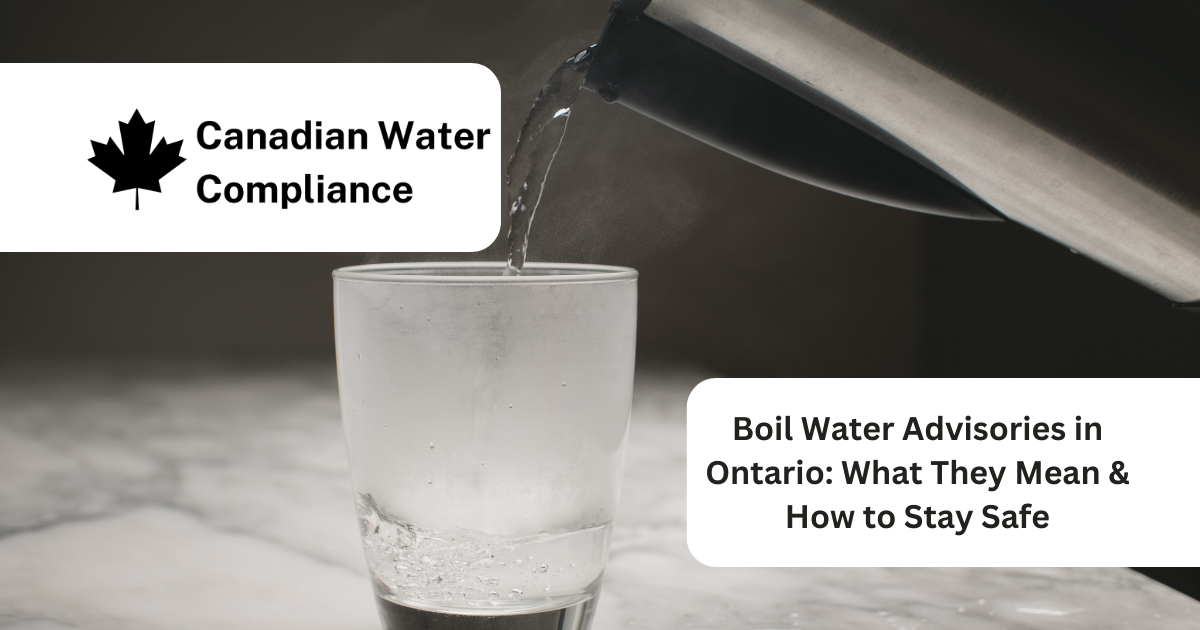
Written By: Canadian Water Compliance | On
Boil water advisories (BWAs) are issued across Ontario when water safety is compromised due to contamination, infrastructure failures, or natural disasters. These advisories serve as critical public health alerts, ensuring that residents and businesses take necessary precautions to avoid exposure to harmful bacteria and pathogens.
For Ontario residents and business owners, understanding what triggers a boil water advisory, how to respond, and when it is safe to resume normal water use is essential. This guide provides an in-depth look at:
What a Boil Water Advisory (BWA) is and why it’s issued
Who is responsible for issuing advisories in Ontario
Steps to take during an advisory
Boiling water procedures & safe storage tips
How businesses can maintain operations during an advisory
How to resume normal water use after an advisory is lifted
A boil water advisory is a public health notice issued when drinking water is contaminated or potentially unsafe for consumption. These advisories are usually put in place due to:
Microbial contamination (E. coli, coliform bacteria, Giardia, Cryptosporidium, etc.)
Water main breaks or low water pressure that increase contamination risks
Sewage system failures leading to cross-contamination
Chemical spills or industrial pollution affecting water sources
Severe weather events (flooding, storms) compromising water quality
In Ontario, boil water advisories are issued by:
Municipal governments (for public water systems)
Local public health units (such as Toronto Public Health, Ottawa Public Health, etc.)
The Ontario Ministry of Health (for provincial water safety regulations)
First Nations and Indigenous Services Canada (for advisories on First Nations reserves)
All boil water advisories are recorded in the Ontario Boil Water Advisory Database, where residents can check for ongoing advisories in their region.
If your area is placed under a boil water advisory, follow these essential steps to ensure water safety:
To kill bacteria and other harmful microorganisms, follow these guidelines:
✅ Bring water to a rolling boil for at least one full minute
✅ Allow water to cool naturally before use
✅ Store boiled water in clean, covered containers
During a BWA, only use boiled or bottled water for:
Drinking
Brushing teeth
Cooking and food preparation
Making infant formula
Washing fruits and vegetables
Use boiled or bottled water to wash dishes by hand
If using a dishwasher, ensure it has a sanitizing cycle
Adults & older children: Can shower, but avoid swallowing water
Infants & toddlers: Use boiled or bottled water for bathing
If you operate a business in the food, hospitality, or healthcare sector, follow Ontario’s Safe Drinking Water Act, 2002 regulations. Businesses may need to:
Use bottled water for food preparation
Provide hand sanitizer in place of tap water
Shut down certain services (e.g., soda fountains, ice machines)
Use clean, BPA-free plastic or glass containers
Keep water covered and refrigerated
Consume within 24-48 hours for best safety
Boil water advisories are lifted only after extensive testing confirms water safety. Residents should wait until they receive an official notice before using tap water normally.
Flush household plumbing – Run all cold water taps for at least 5 minutes
Replace water filters – Including fridge, faucet, and pitcher filters
Sanitize water dispensers and ice makers – Discard old ice cubes
Run dishwashers on a full sanitization cycle
Regularly test private well water (Ontario recommends at least 3x per year)
Ensure backflow prevention devices are installed in plumbing
Properly maintain septic systems to prevent contamination
Monitor local water quality reports for early warnings
Boil water advisories are critical public health warnings designed to protect against contaminated drinking water. By understanding why advisories are issued, how to respond, and what steps to take when they are lifted, Ontario residents and businesses can ensure safe drinking water practices and maintain public health standards.
Need professional water testing to safeguard your home or business? Contact Canadian Water Compliance today for expert analysis, monitoring, and compliance solutions!